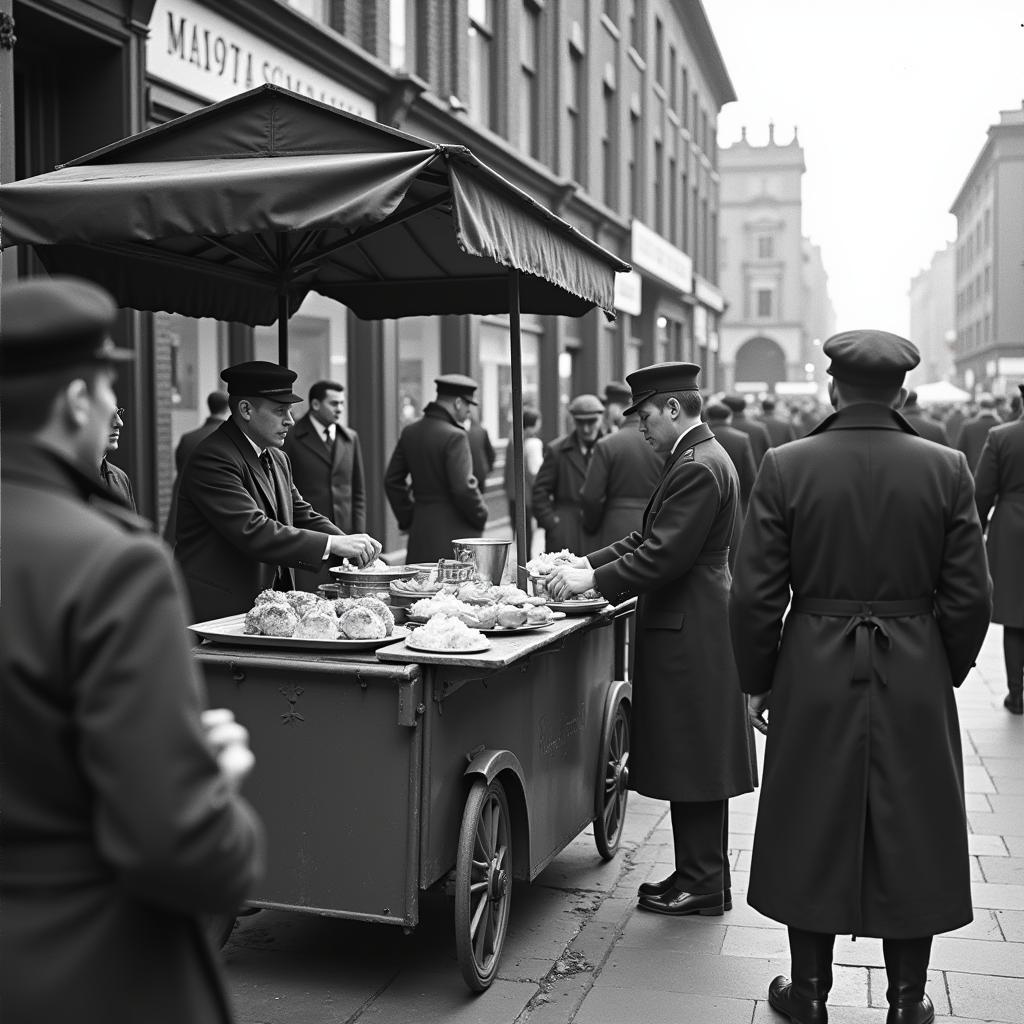1942 Street Food conjures images of a bygone era, a time when food was simple yet bursting with flavor. Step back in time with us as we explore the fascinating world of street food during this pivotal year. We’ll uncover the stories behind these culinary delights and discover how they reflected the social and cultural landscape of the time.
Rationing and Resourcefulness: The Backdrop of 1942 Street Food
The year is 1942. World War II raged on, impacting every facet of life, including the culinary landscape. Rationing was in full swing, limiting access to everyday ingredients like sugar, meat, and butter. Yet, amidst these challenges, street food vendors displayed remarkable resilience and ingenuity.
 Street food vendor during wartime
Street food vendor during wartime
Resourcefulness became the name of the game. Vendors relied on seasonal produce, readily available ingredients, and creative substitutions to craft affordable and satisfying meals for those on the go. Dishes were often simple but packed with flavor, reflecting the culinary traditions of their respective cultures.
A Taste of the Times: Popular 1942 Street Food Choices
From the cobblestone streets of London to the vibrant markets of New York City, certain street food staples defined the 1942 culinary experience.
1. Fish and Chips: A British Staple Endures
Even during wartime, the comforting aroma of fish and chips wafted through the air in Britain. While fish wasn’t rationed, its availability fluctuated. Vendors adapted by using whatever fish was plentiful, often coating it in a thick batter to stretch portions further. Served in paper cones with a generous sprinkle of salt and vinegar, fish and chips provided a much-needed taste of normalcy.
2. Hot Dogs: An American Classic on the Go
In the United States, hot dogs emerged as a popular wartime street food. Relatively inexpensive and easy to prepare, hot dogs were sold from pushcarts and street stands, often nestled in soft buns and topped with mustard and relish. They became a symbol of American resilience and a quick, satisfying meal for workers and soldiers alike.
3. Corn on the Cob: A Taste of Summer’s Bounty
As a readily available and affordable crop, corn played a starring role in 1942 street food. Whether roasted over an open fire or boiled until tender, corn on the cob was a simple yet satisfying treat. Street vendors often brushed the hot ears with butter or margarine and sprinkled them with salt and pepper, enhancing their natural sweetness.
“Corn on the cob was a symbol of hope,” notes culinary historian Emily Carter. “It was a reminder of simpler times and the bounty of nature, even amidst the turmoil of war.”
The Legacy of 1942 Street Food
The street food of 1942 offers us a glimpse into a time of resourcefulness and resilience. It highlights the power of food to unite communities and provide comfort during challenging times. The next time you enjoy a simple street food delight, take a moment to appreciate the ingenuity and spirit that shaped these culinary traditions.
FAQ
Is there any specific website or resource where I can find authentic 1942 street food recipes?
While there might not be websites dedicated solely to 1942 street food recipes, numerous online resources and cookbooks focus on wartime recipes and rationing-era cooking. These often include adaptations of popular street food items using readily available ingredients.
Need More Information?
For any assistance, please contact us at Phone Number: 02437655121, Email: [email protected]. Or visit us at: 3PGH+8R9, ĐT70A, thôn Trung, Bắc Từ Liêm, Hà Nội, Việt Nam. We have a 24/7 customer support team.